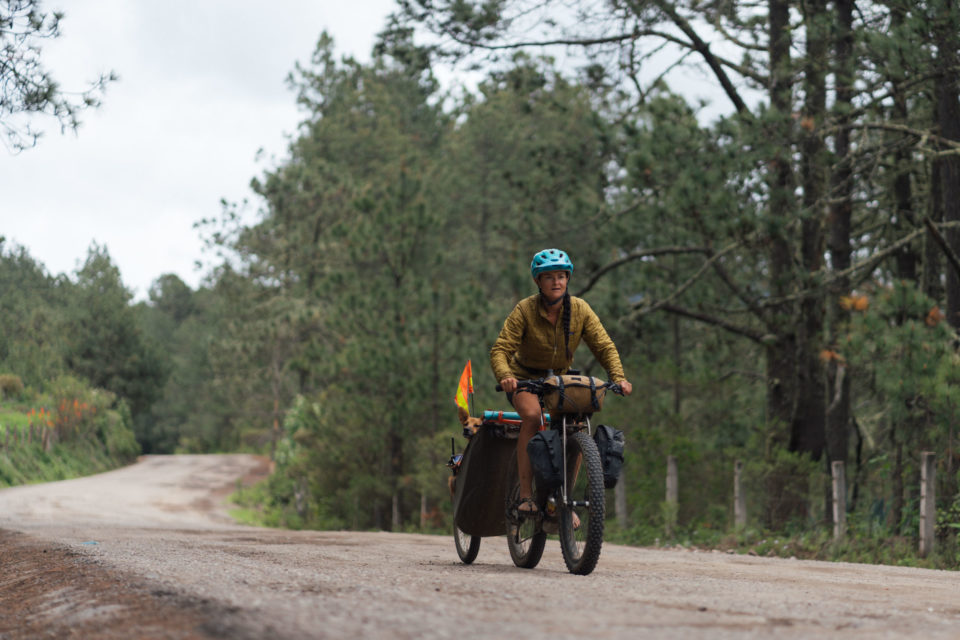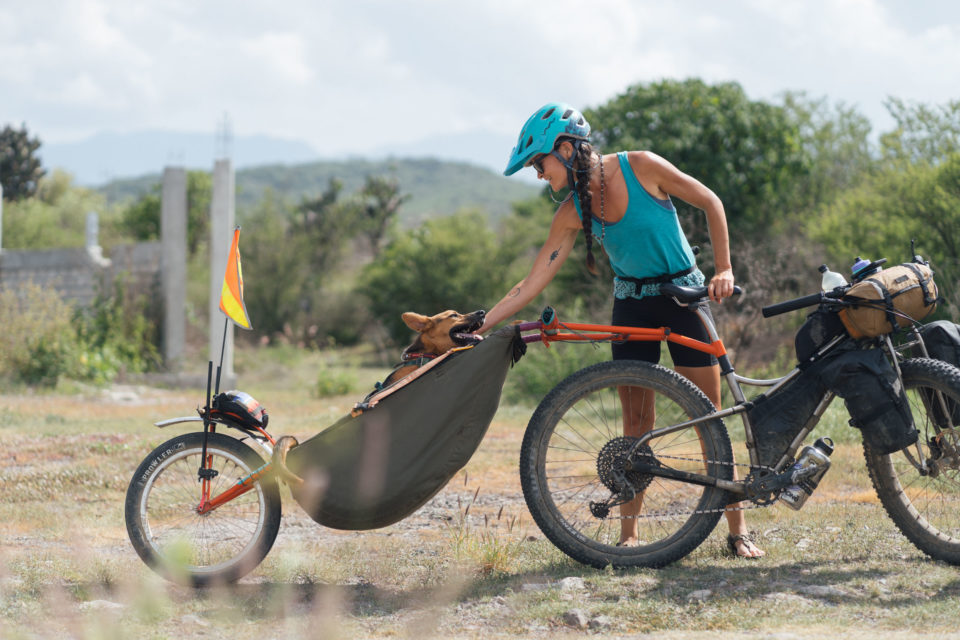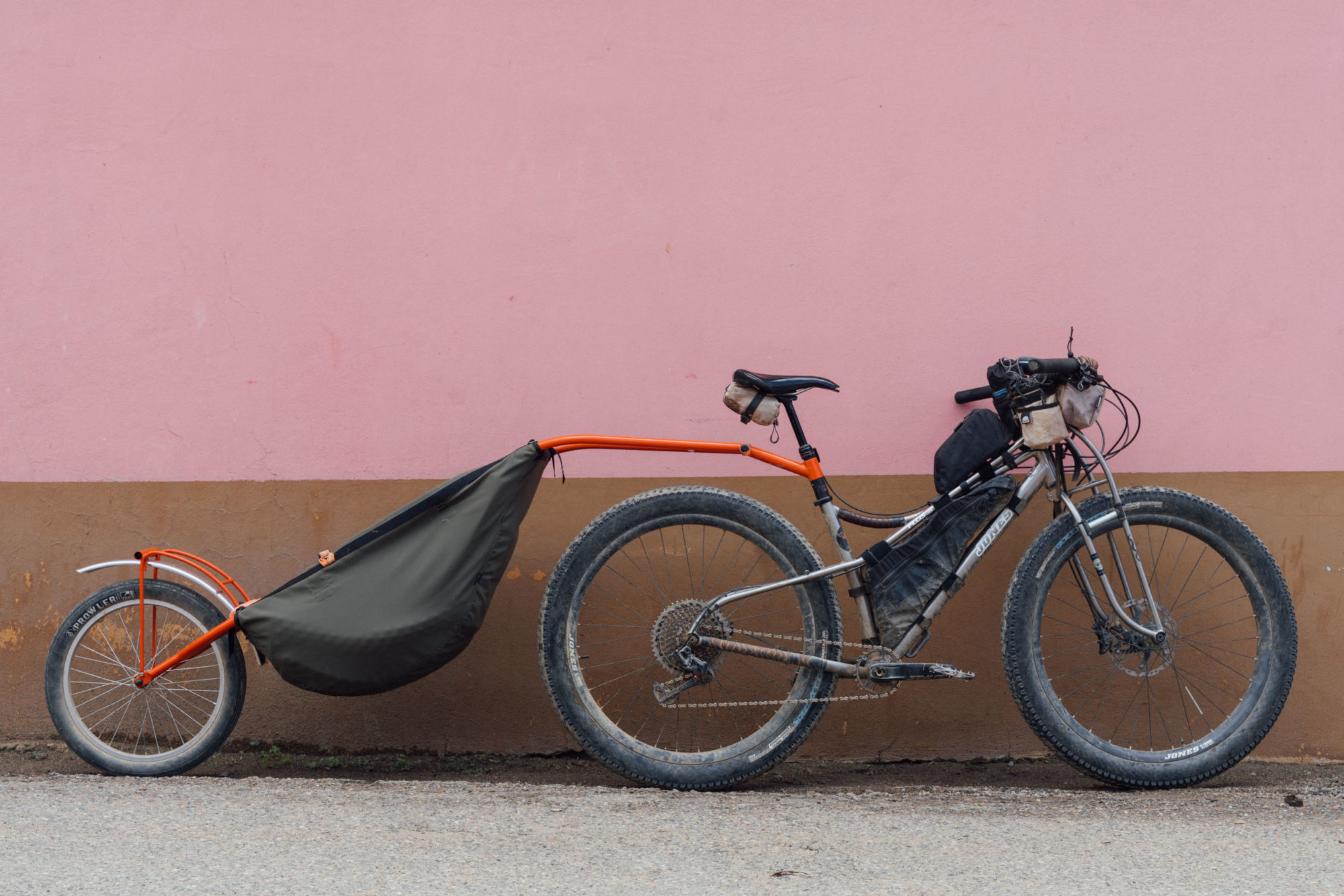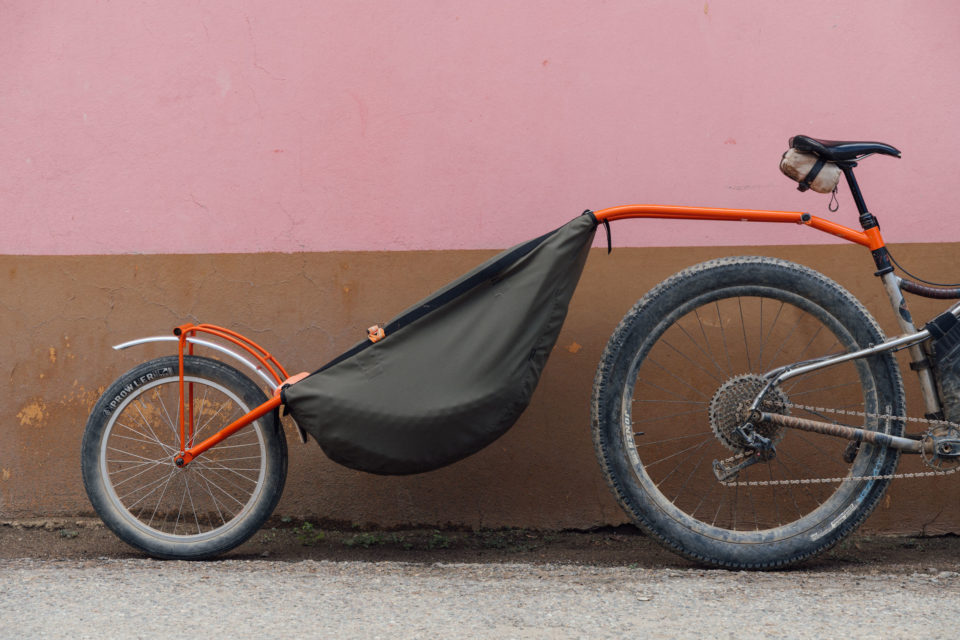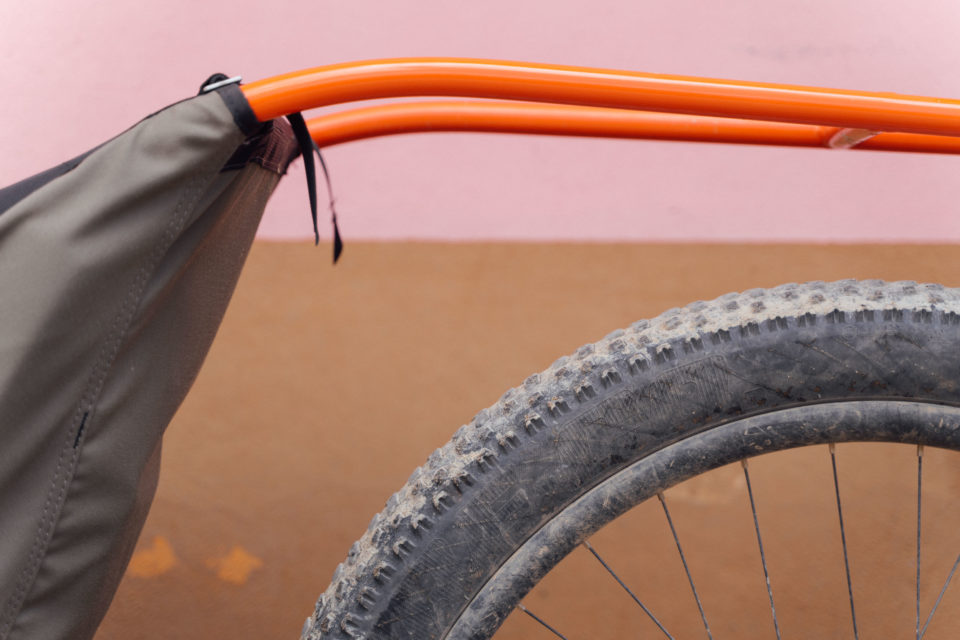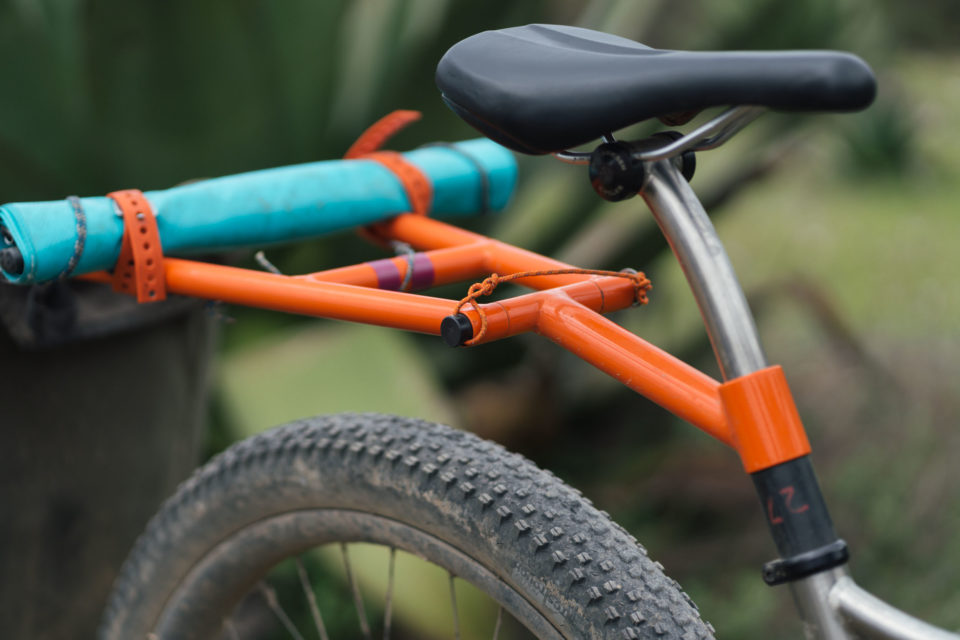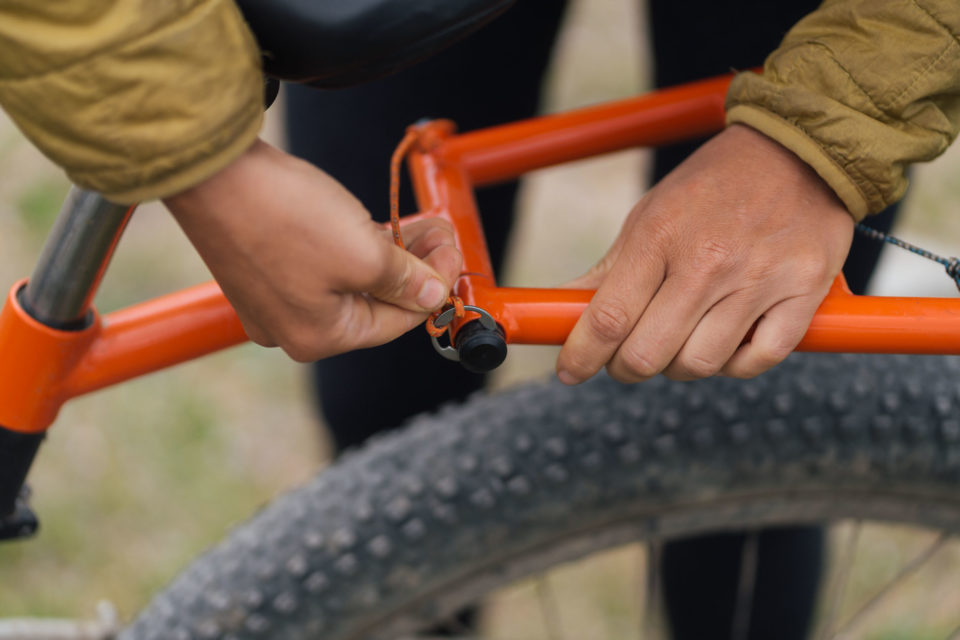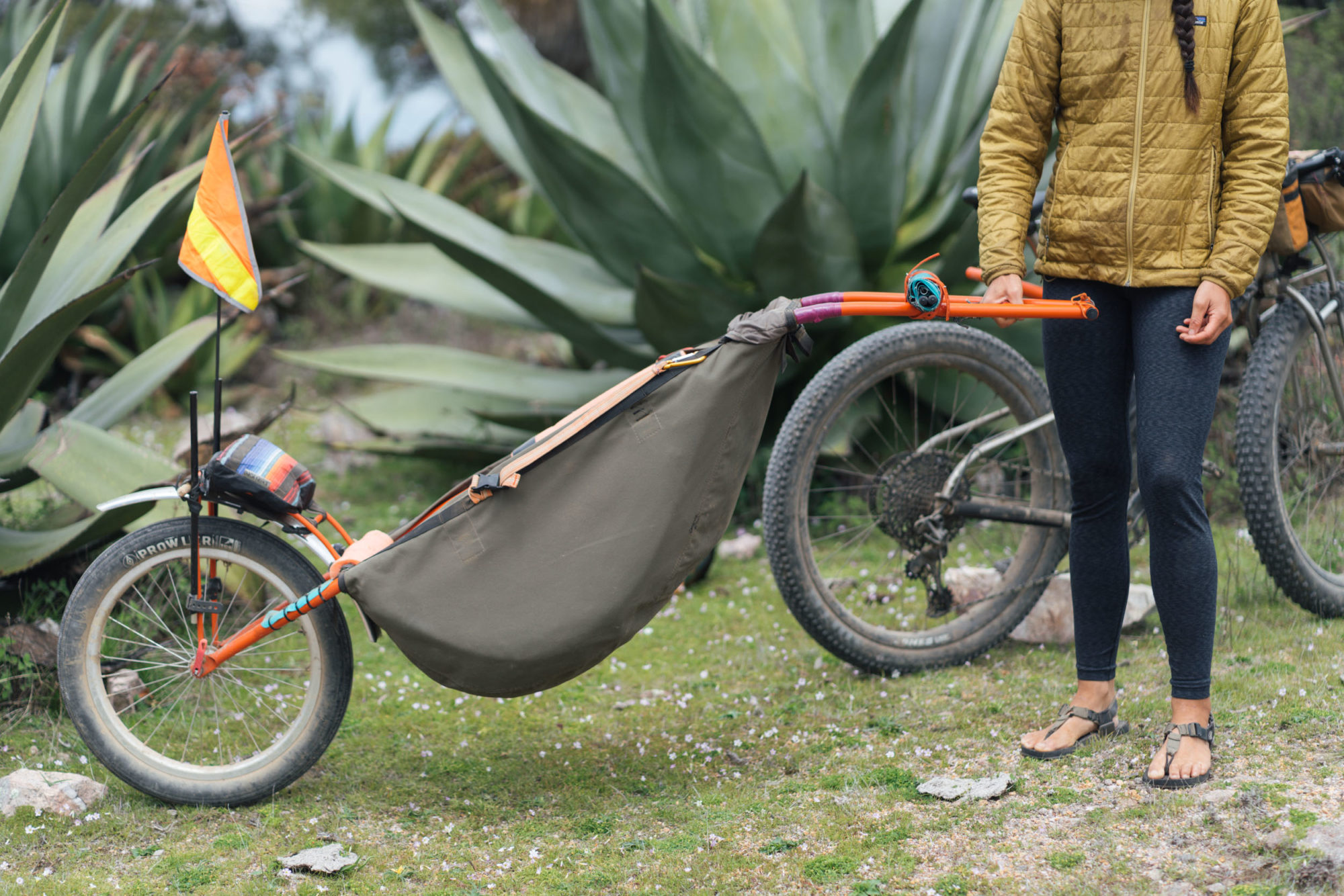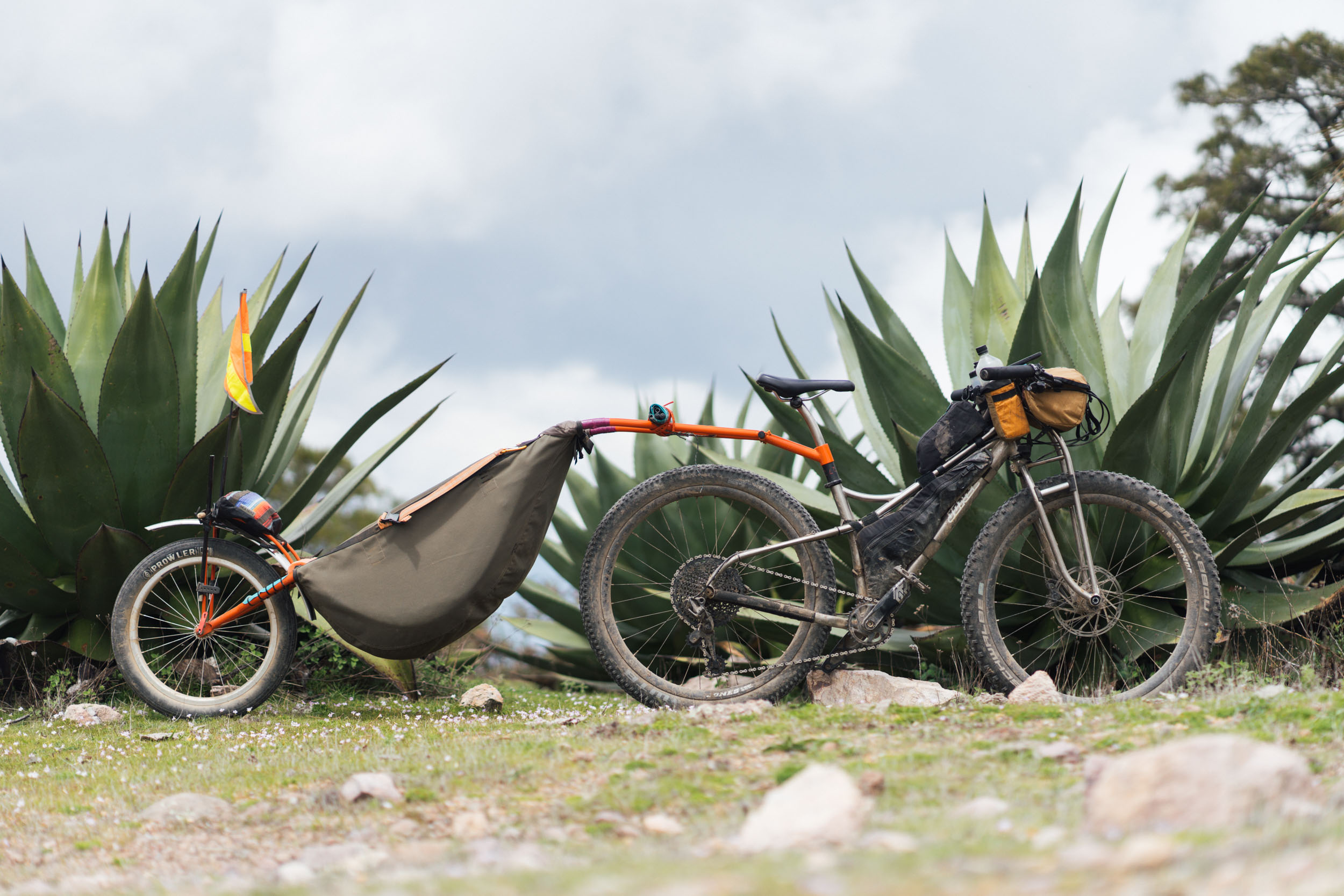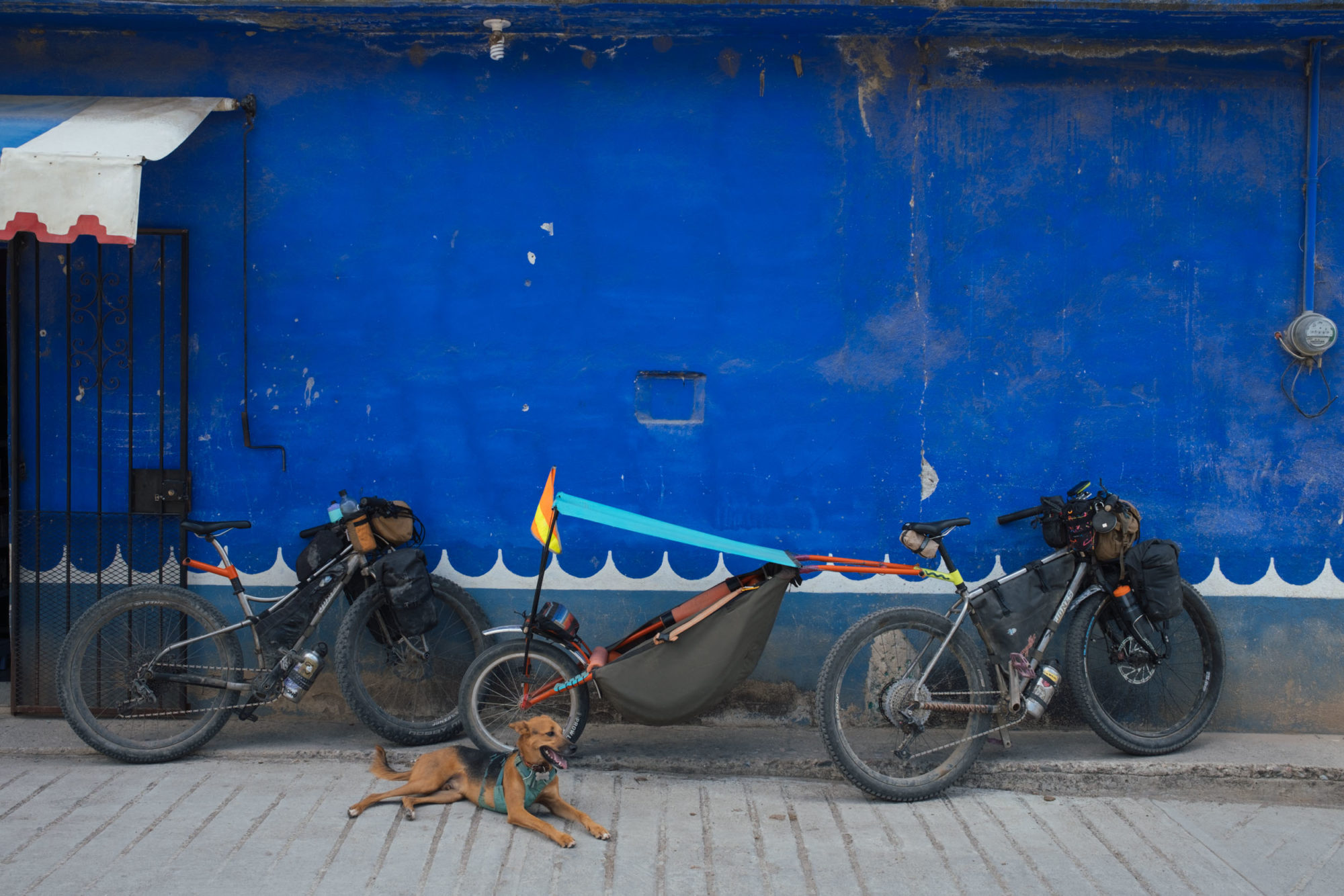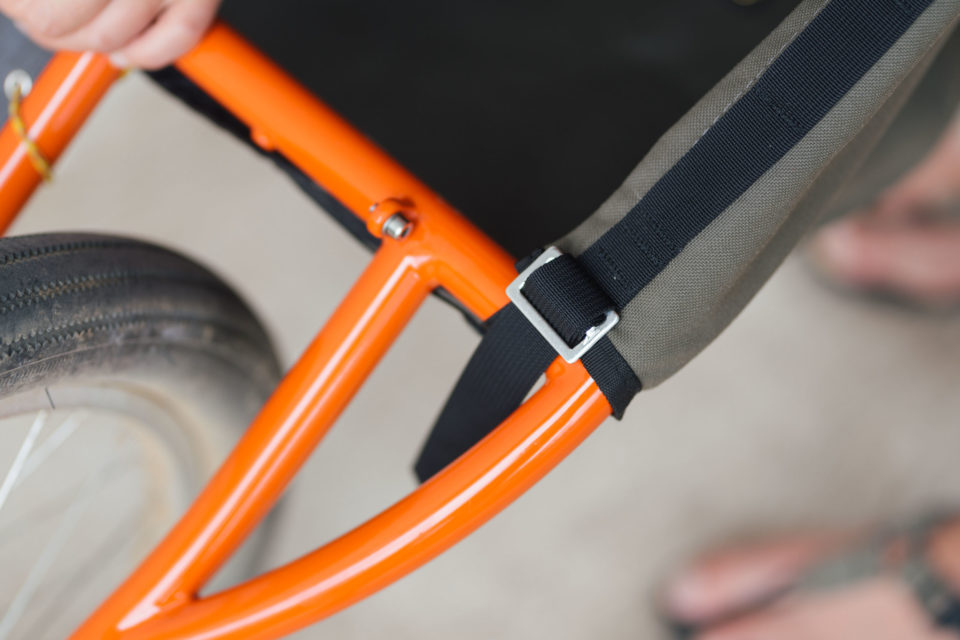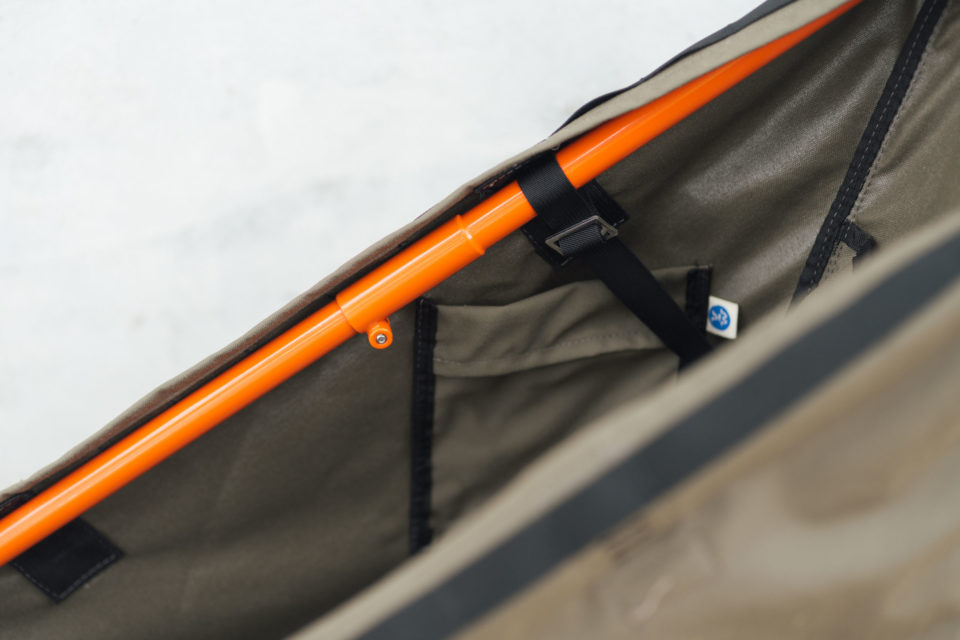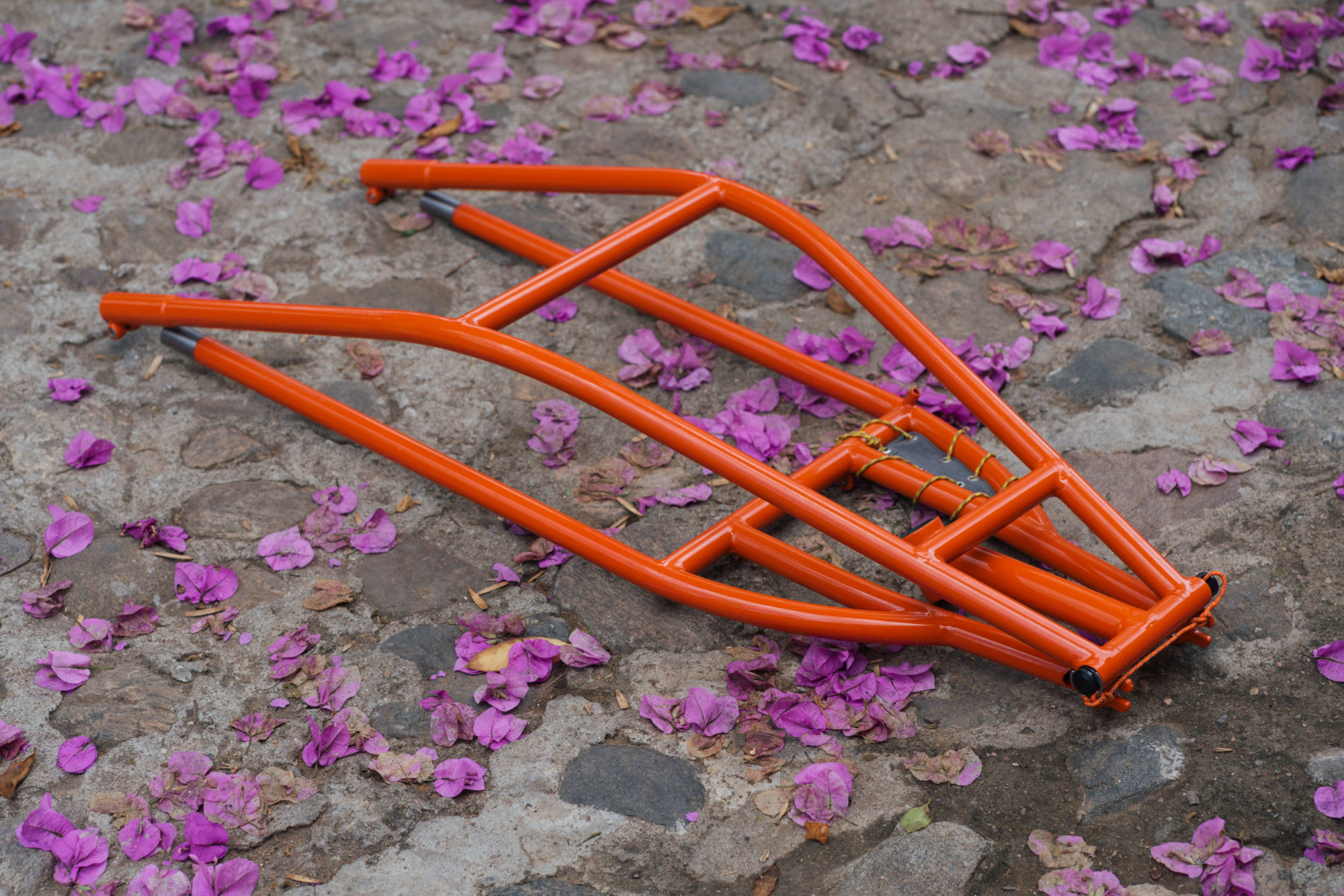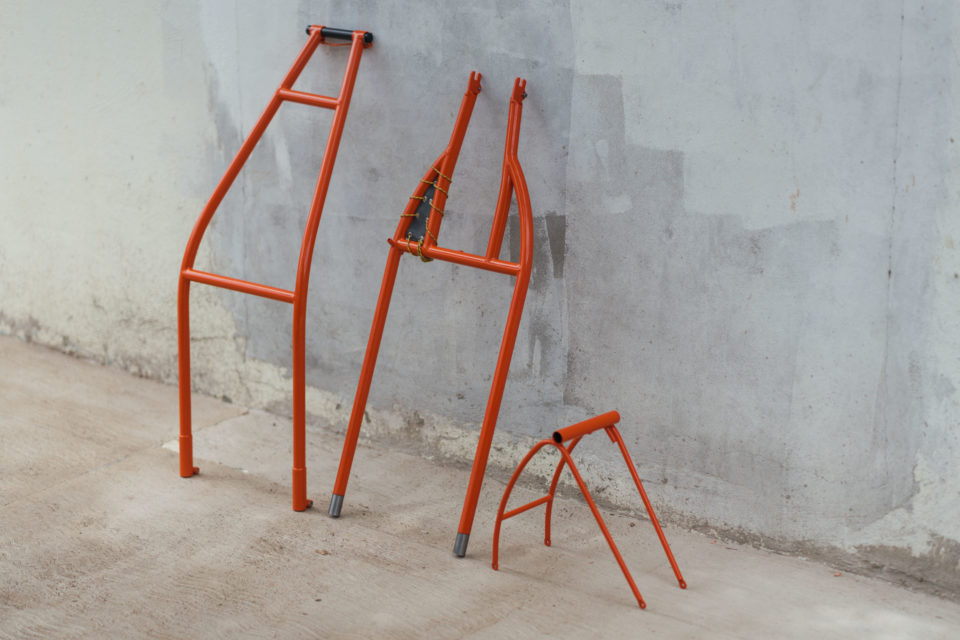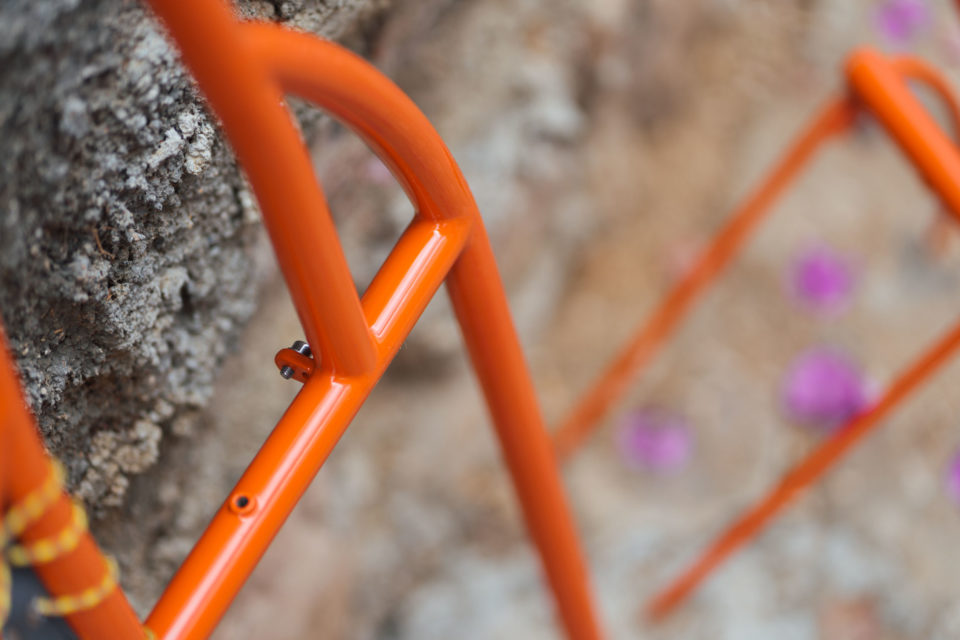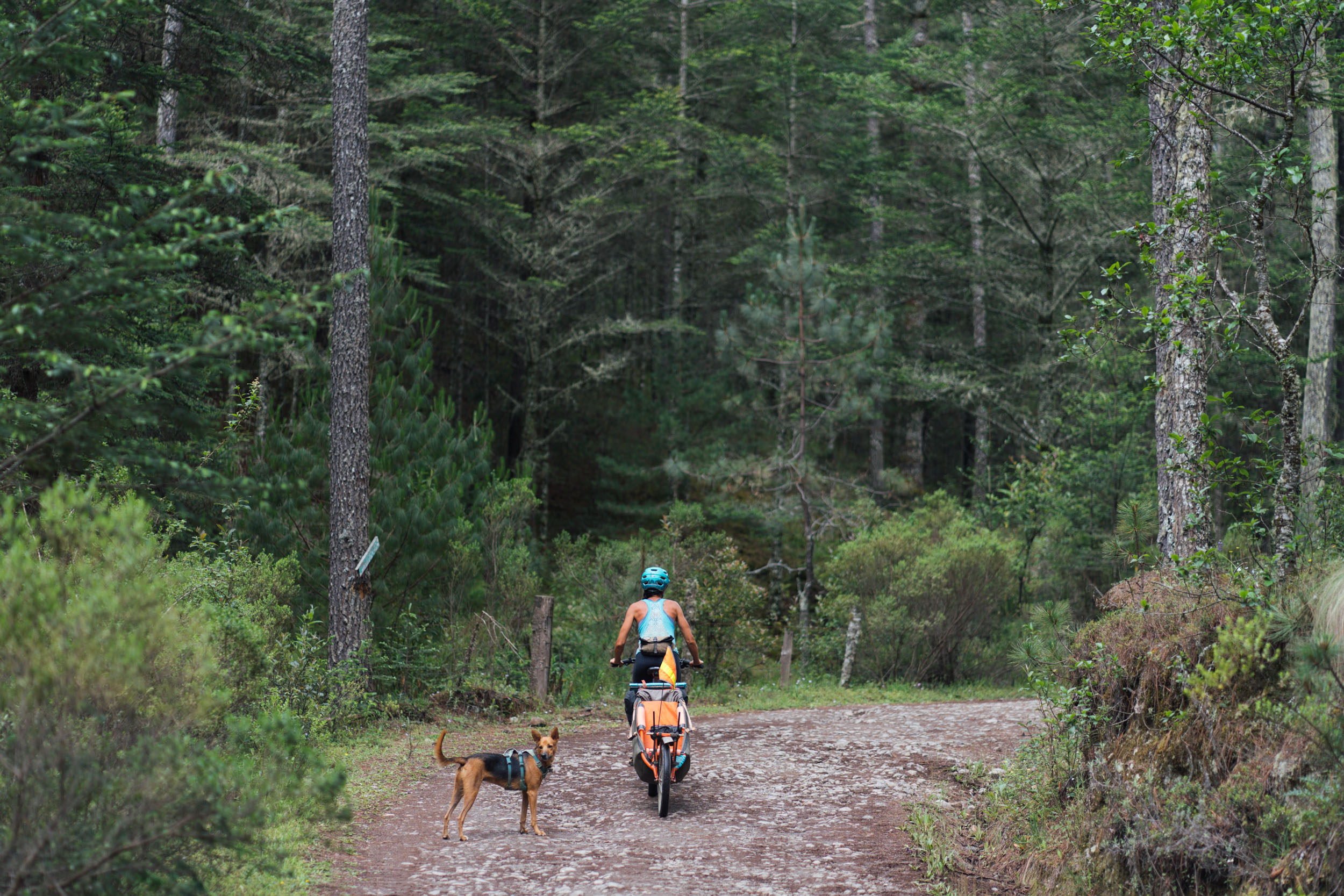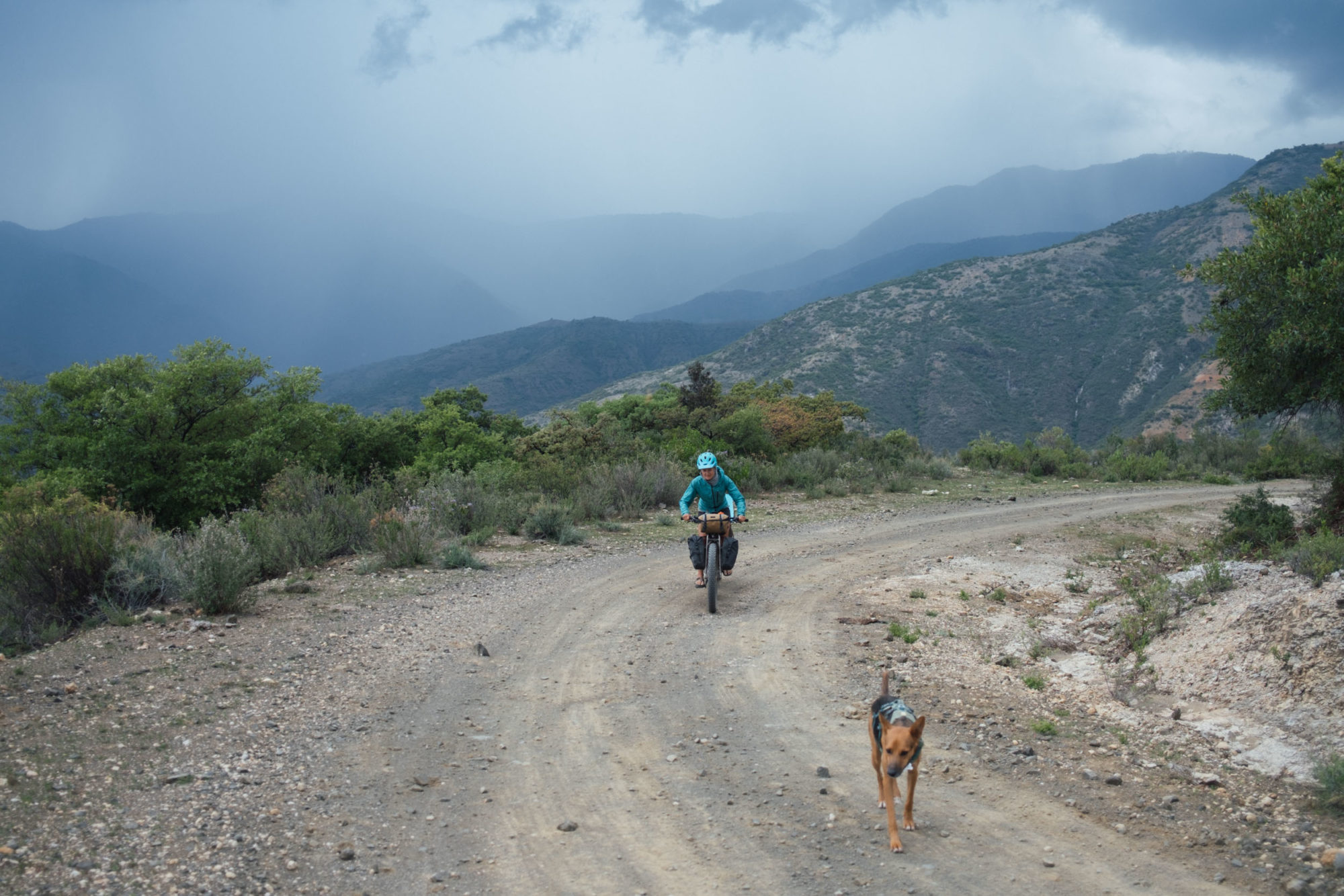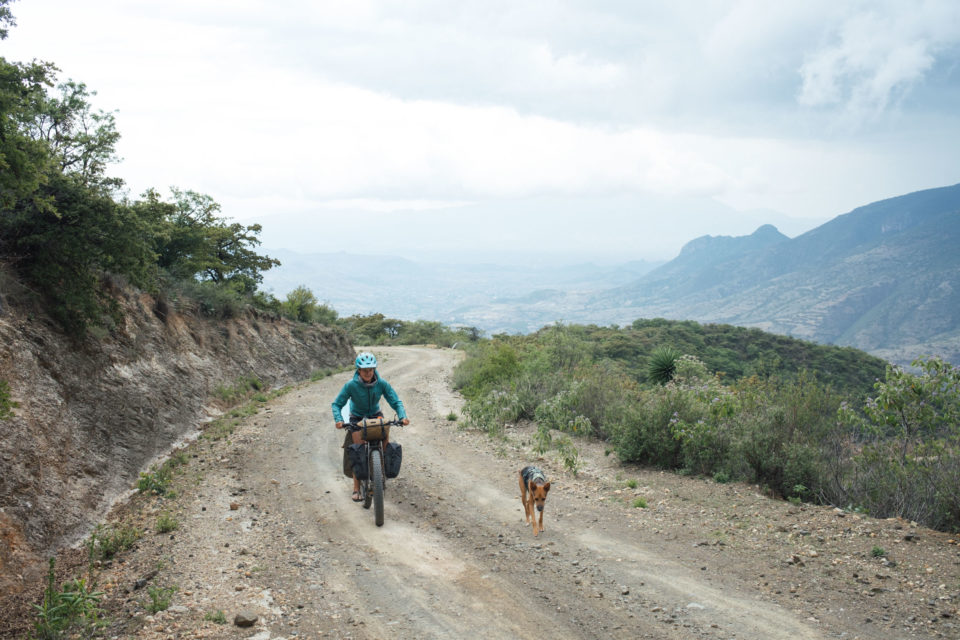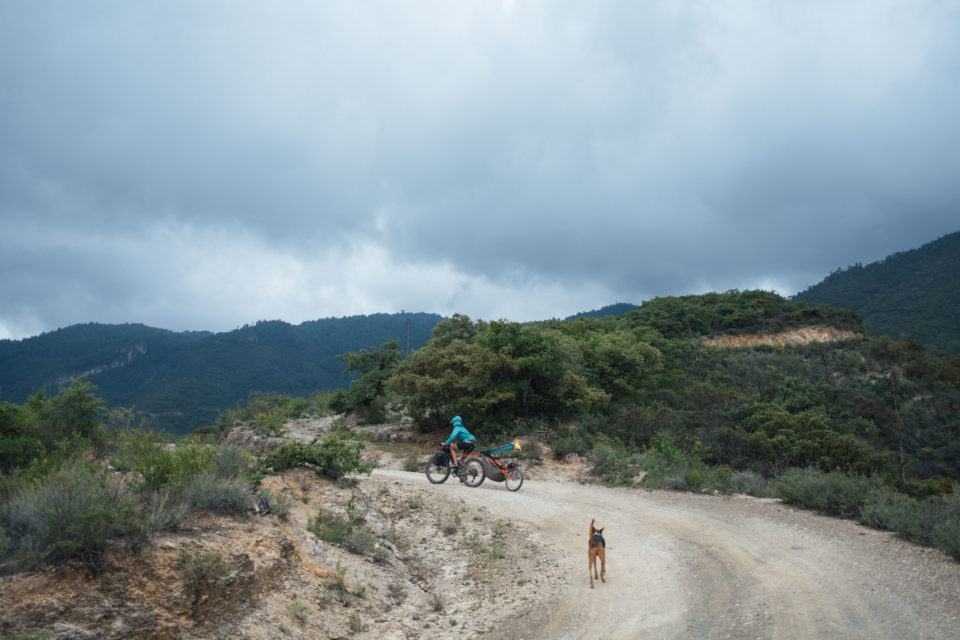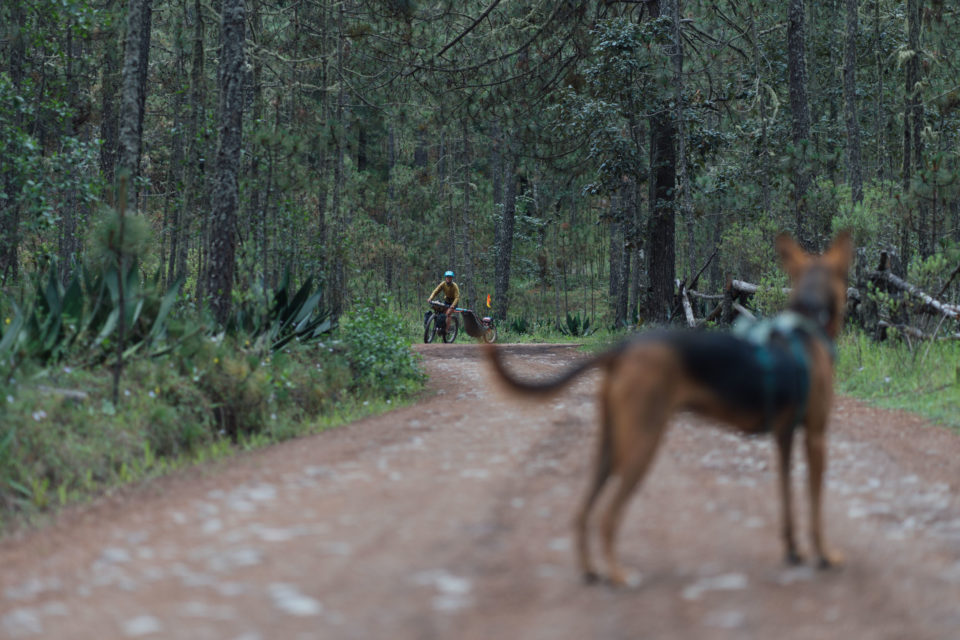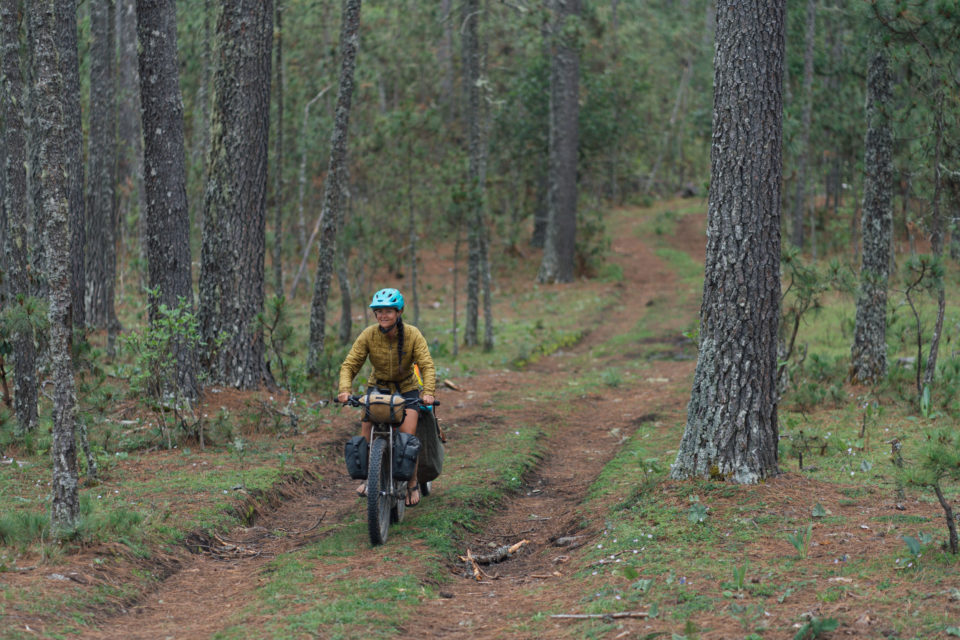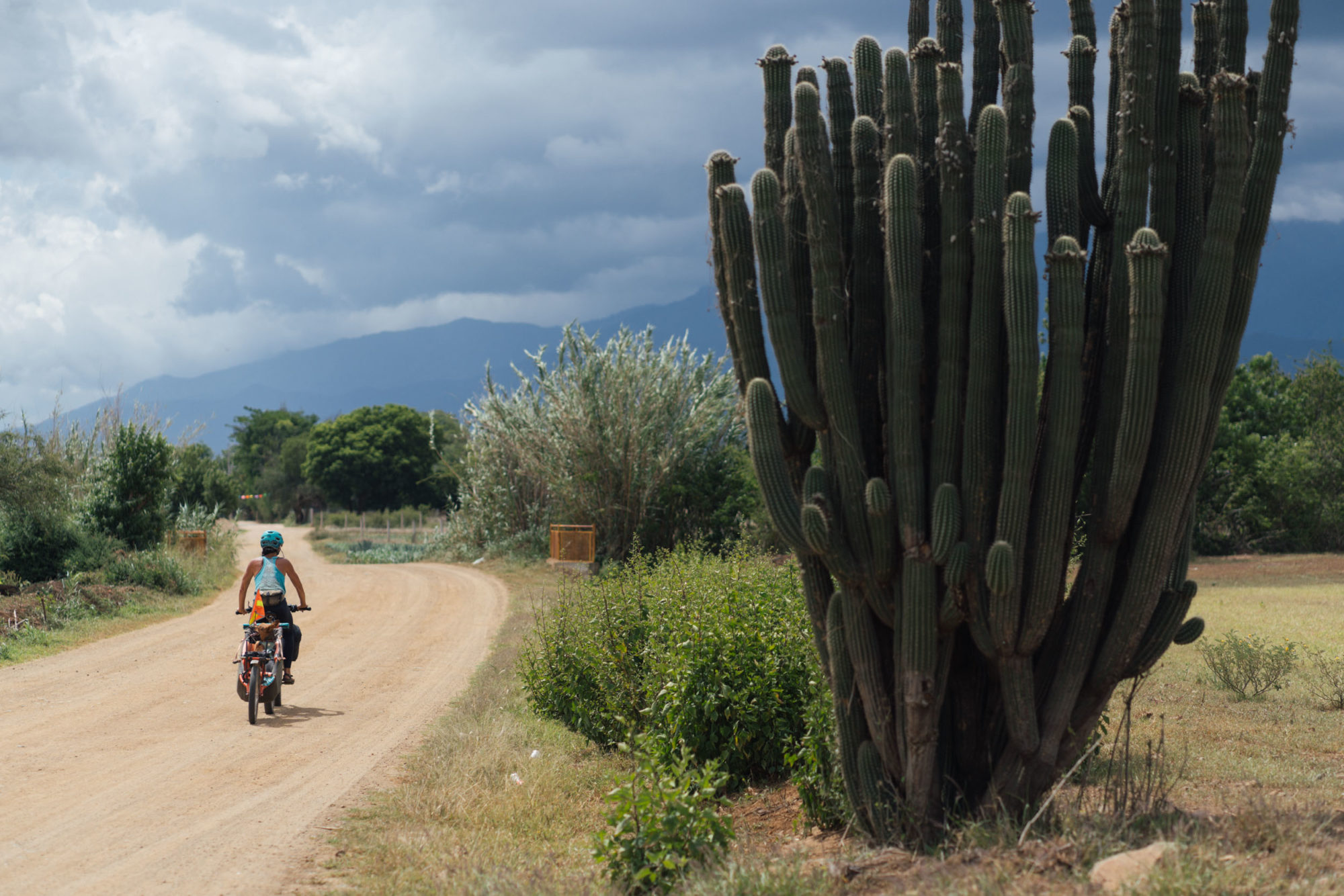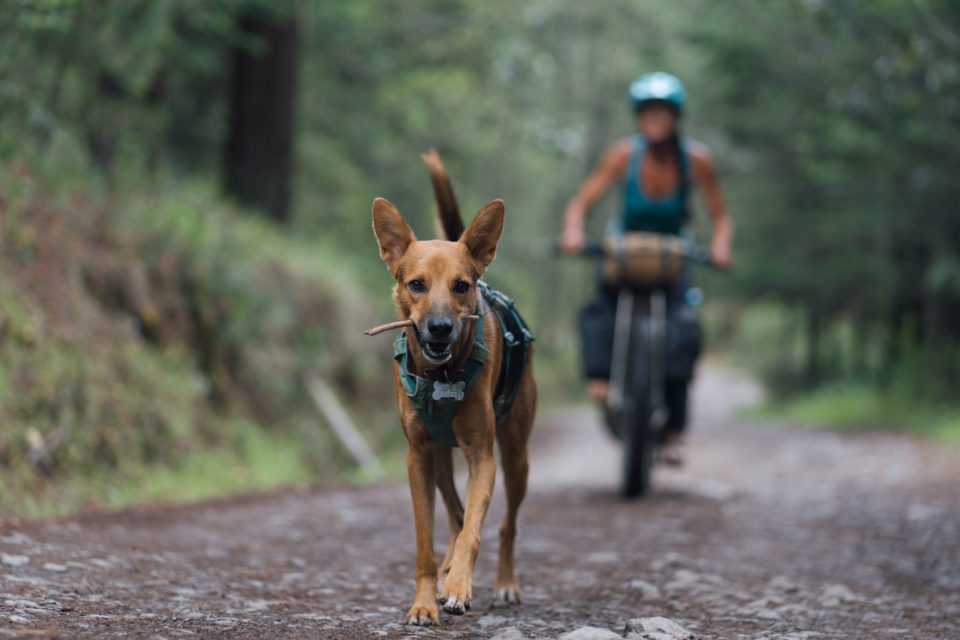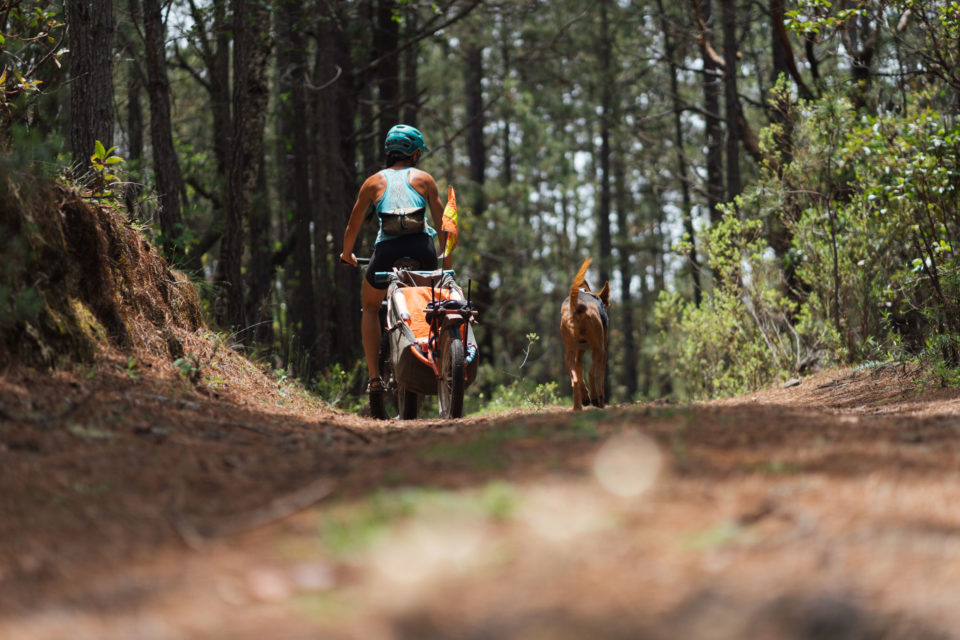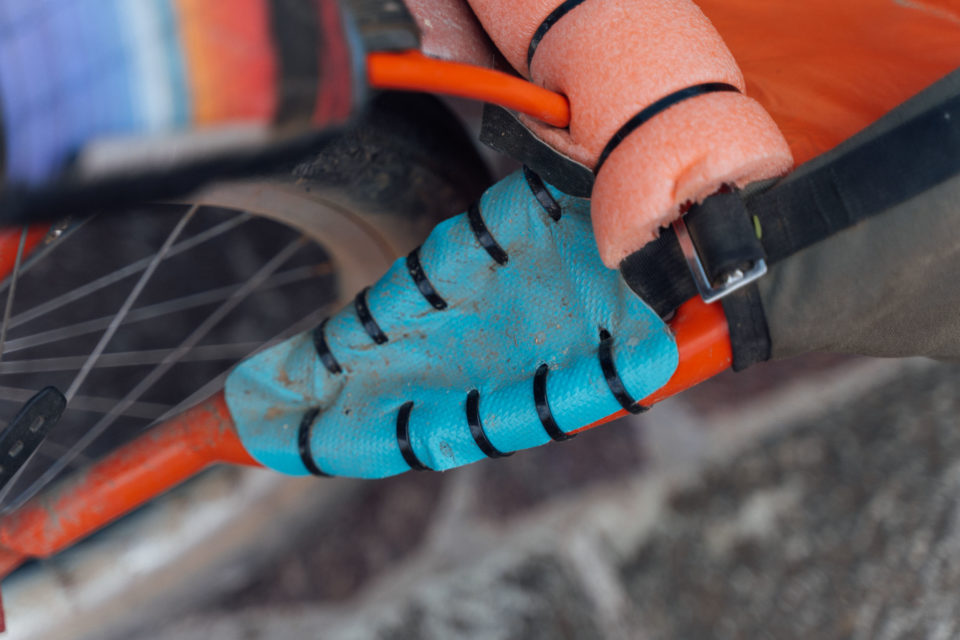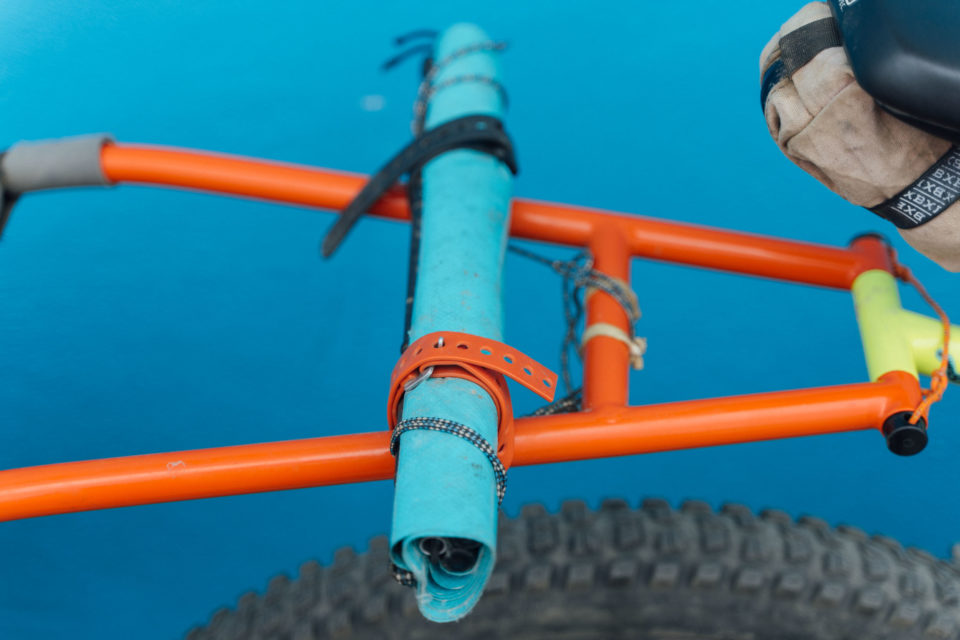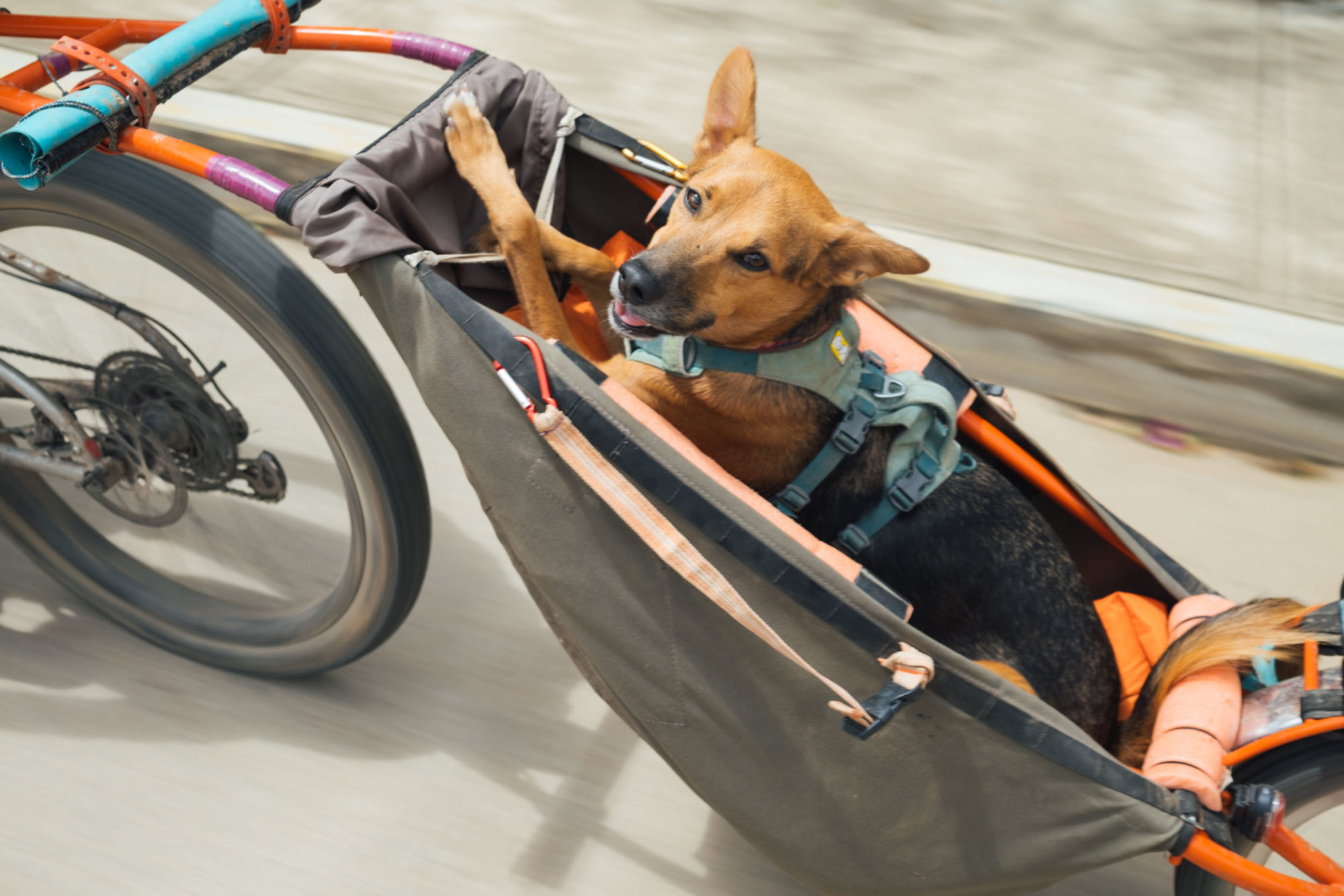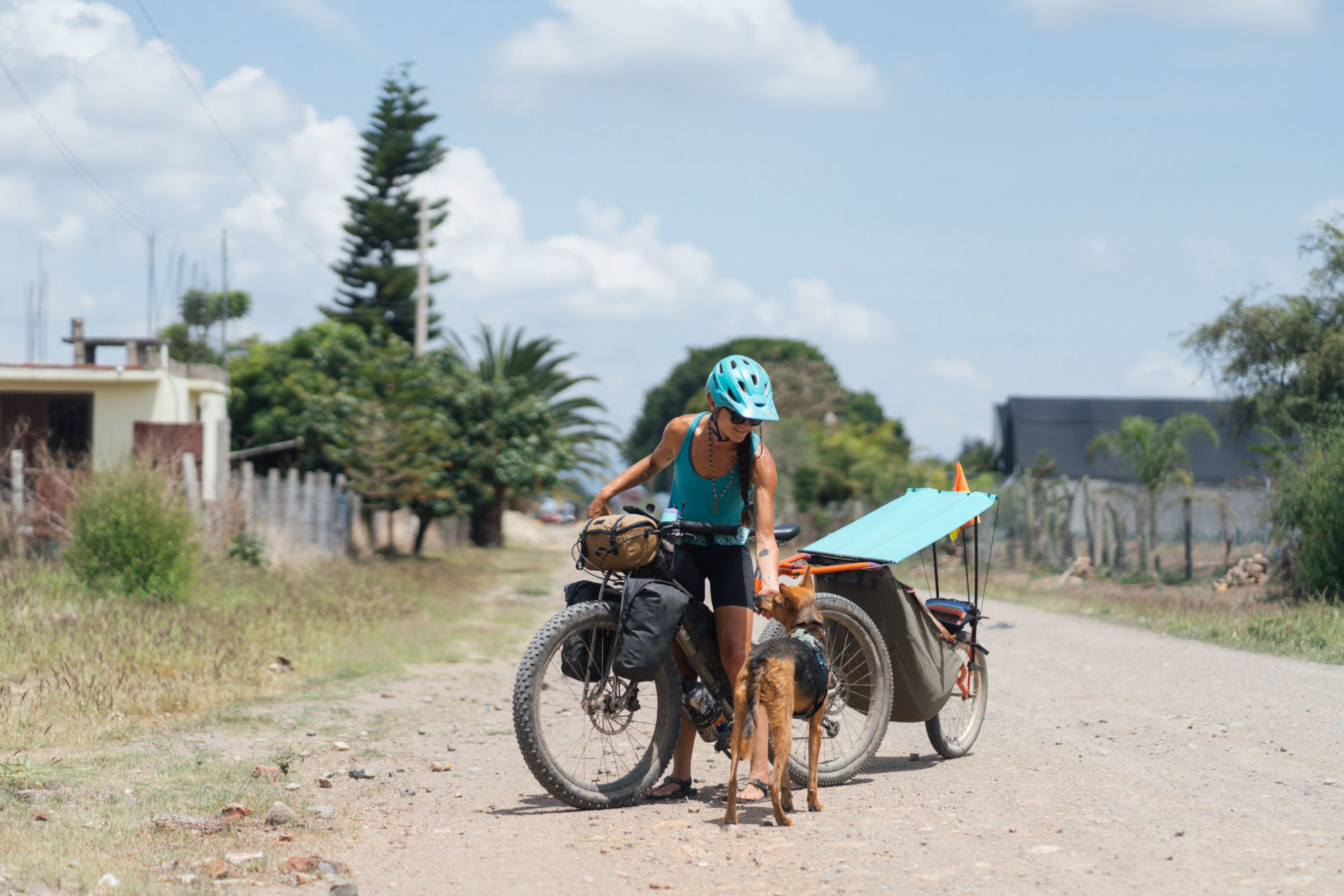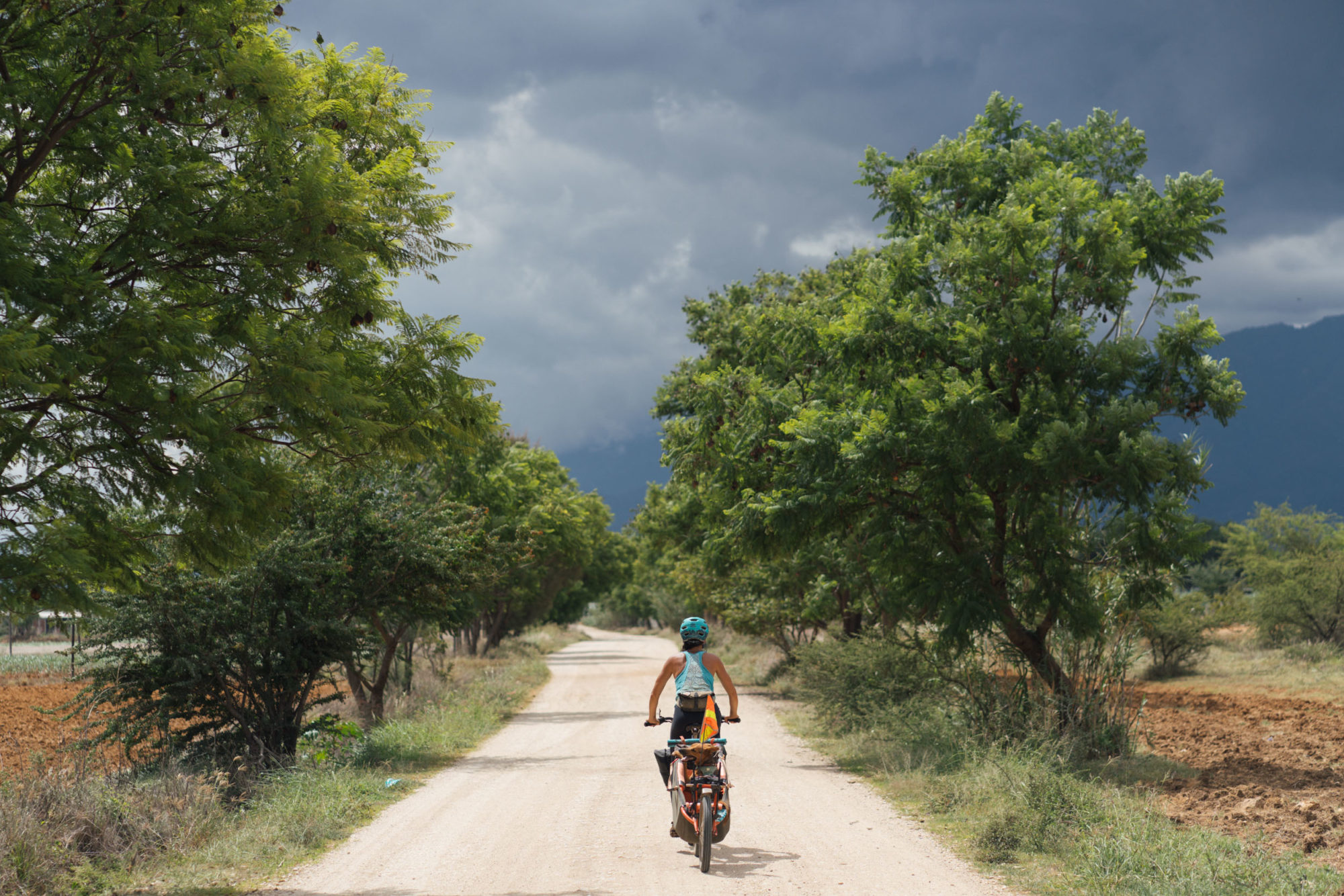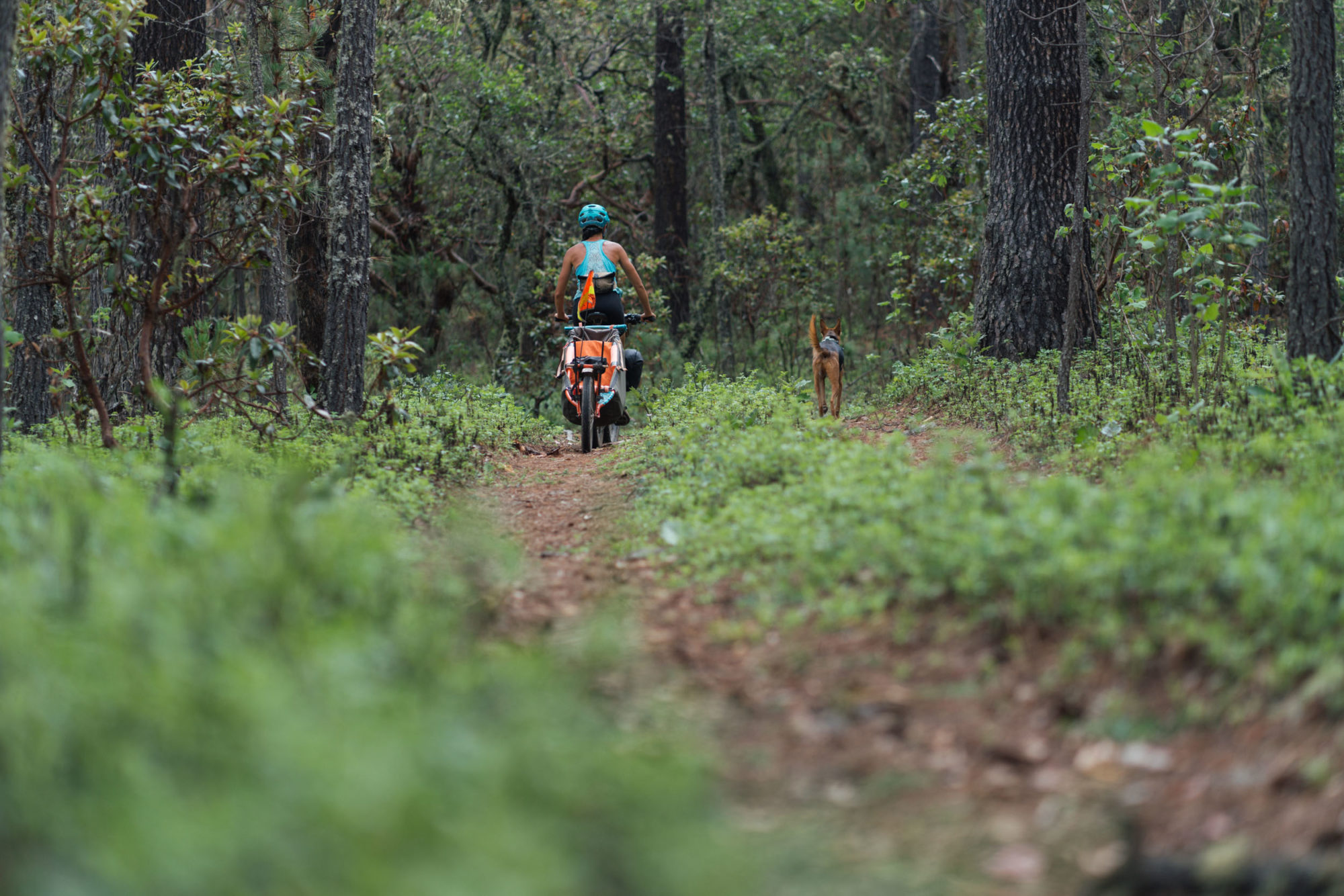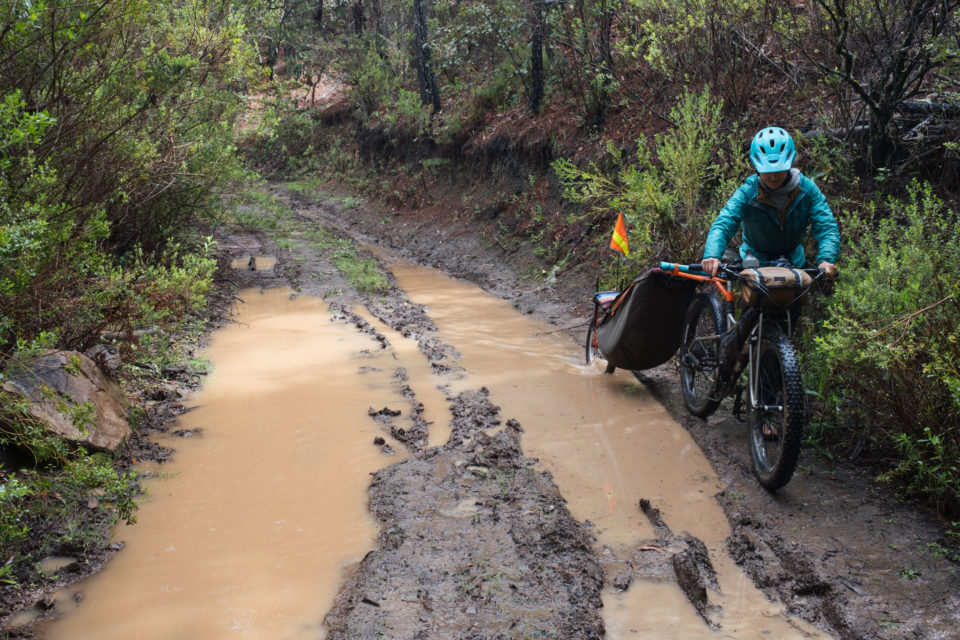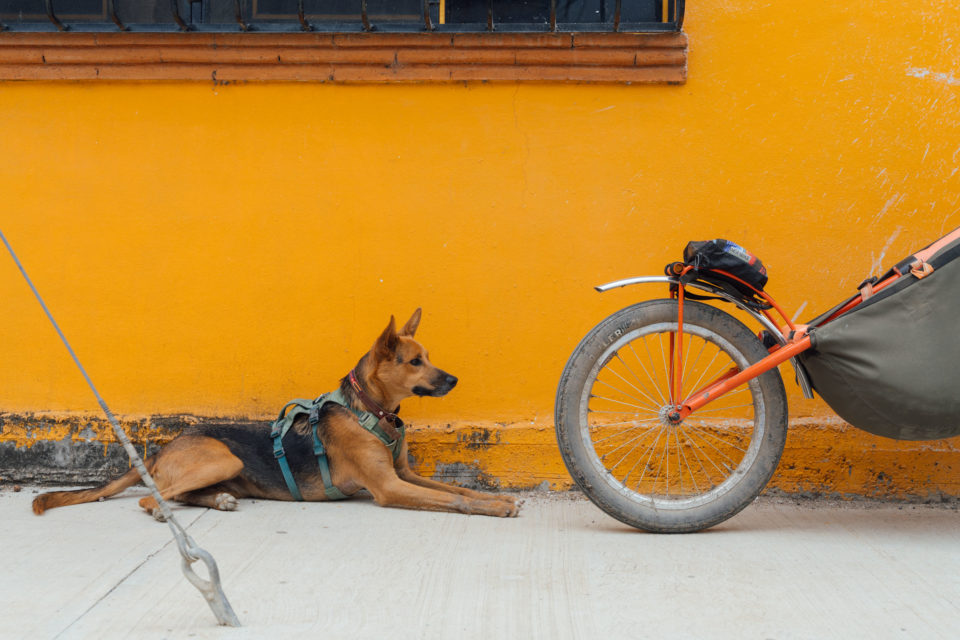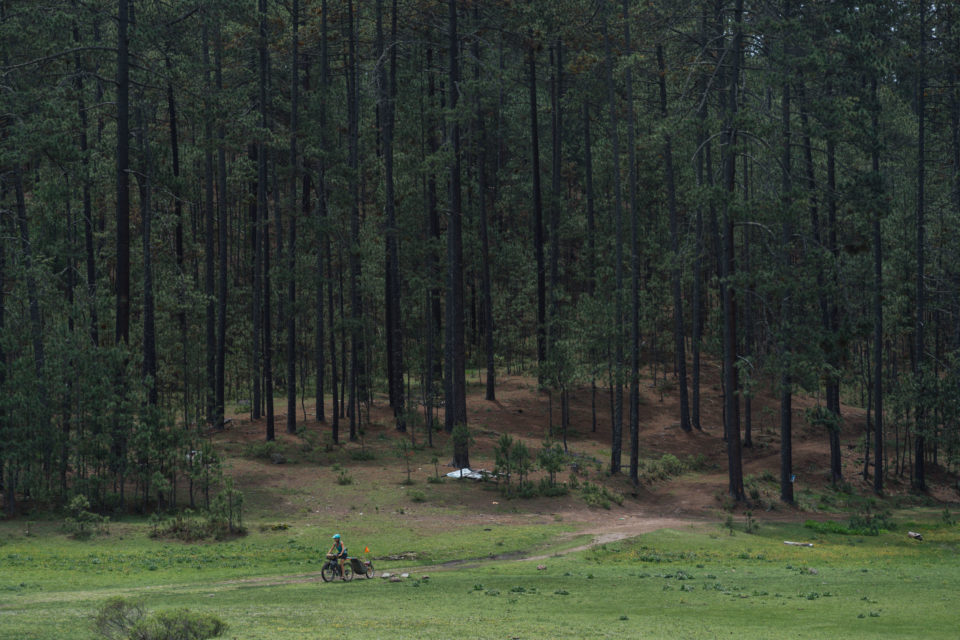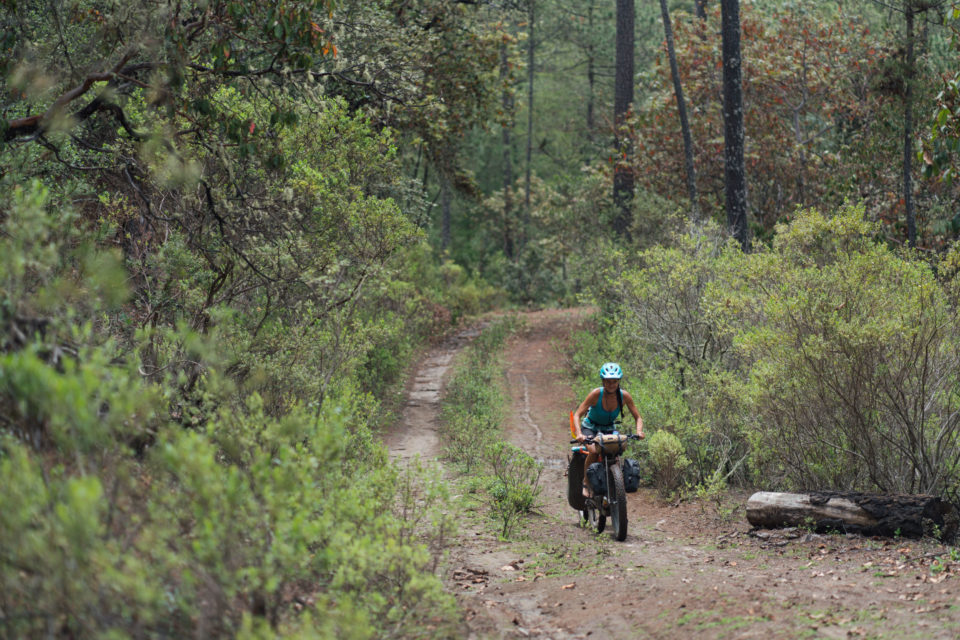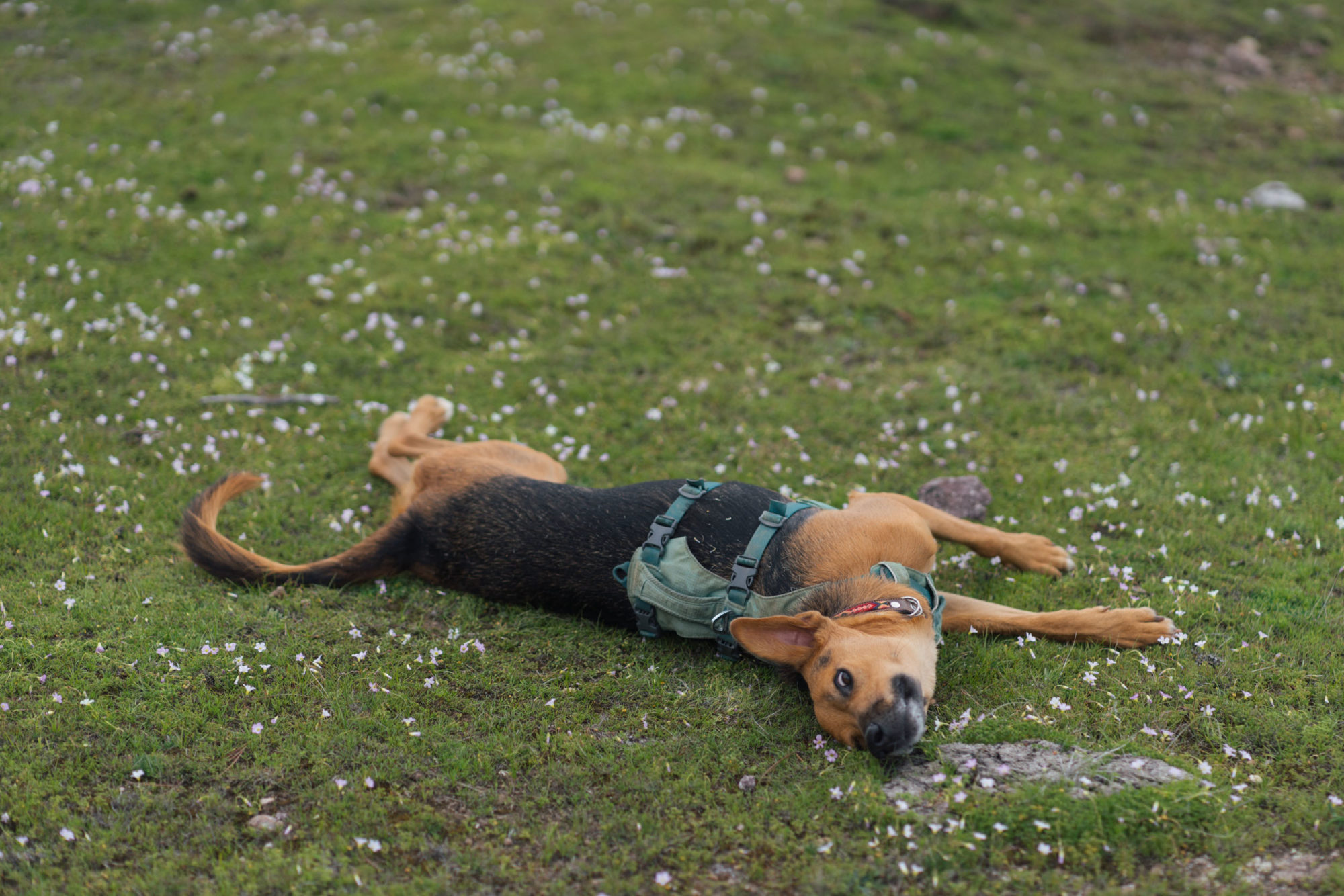
[ad_1]
Share This
0
Thanks in advance for spreading the word!
Bicycle trailers can help turn our more off-beat and imaginative bikepacking aspirations into reality, be it by carrying a surfboard across Baja or bringing your dog along for the ride. Mexican callejero Huesos and his humans try out Frances Cycles’ Farfarer over a number of trail rides and multi-day trips into the mountains, reporting in with their respective findings…
Foreword: Whilst these words, images, and impressions revolve around a particular dog as a form of cargo, there’s nothing to stop you from swapping a dense mass of muscle and fur for a family-size tent and accompanying paraphernalia, or extra water on a desert trip, or anything else you think of for that matter, including a surfboard or even three cats.
If you’ve been keeping track of Huesos’ dogpacking adventures, you’ll have seen us shift from one method of conveyance to the next, the latest being this Farfarer single-wheel trailer by Frances Cycles.
In part, this is because Huesos’ long limbs can no longer be contained within the confines of the milk crate we used on our first trips. And, it’s because he now weighs a more consequential 40lbs (18kg). This change comes as a welcome contradiction to his name (Bones, in English), which was all he was when we first we found him, and can be credited to the bottomless bag of kibble and giant vat of bone broth that I’m happy he now takes for granted.
Options for medium-sized dogs
Like any bicycle obsessive, I considered our options. There are ‘midtails’, a la John and Mira La Perra’s titanium Carver or the now discontinued Salsa Blackborow, with extended rear racks to support a longer and broader crate. But cost and transportation logistics to Mexico quickly ruled them out, along with the fact that midtails carry their loads relatively high – since Huesos hasn’t proved himself to be much of a jumper thus far, it would mean hoisting him up and down a number of times throughout the day. From past experience, I knew this would likely wreak havoc on my back. There are also more cargo-specific avenues, where the weight is carried lower, like JC and Basquiat’s wonderful Omnium. But again, as much as I’d love to own such a bike one day, it seemed like an unnecessarily big investment for now, as well as being more of a compromise off-road.
Trailers, on the other hand, sit low enough to the ground that a dog can easily hop in and out by itself, and if tired or more advanced in their years, it’s less of an effort to offer them a helping hand. They can also be added or sustracted to your existing setup. Depending on needs, they can be moved from bike to bike, or shared around. Financially, they’re far less committing than a full-fledged cargo bike, and they’re easier to travel with – they can be tucked away under a bus en route to your journey’s starting point, or in the boot of a car.
What’s more, I love to bikepack on a mountain bike because I can offload my gear and enjoy any trails I find unladen, which trailers allow you to do. But there are downsides too. Trailers add length to your setup, can be awkward to thread through trafficked city streets, and there’s extra weight and rolling resistance to contend with. Most notably for dogpacking, they put distance between you and your furry friend. Little beats having your dog close enough to lavish with on-the-move affection, but unless you have arms the length of Mr Tickle, it’s something you’ll have to forgo.
Handmade in California
The Farfarer is a chromoly trailer that’s handmade in Santa Cruz, California, by Joshua Muir, a custom framebuilder of considerable repute, with a portfolio of exquisite randonneur bikes and mixed step-thrus, along with all manner of remarkable cargo machines in his repetoire. Be sure to check out Logan’s excellent shop visit for examples. Although more straightforward in its execution, it’s perhaps no surprise that the Farfarer is as gorgeously made as anything else in his lineup; I sometimes find myself pausing to admire its elegant profile and lustrous finish.
There are two models in the Farfarer range. One is the ‘Standard Farfarer’ ($600) which can accommodate a 20″ tyre that’s up to 2.5in wide. The other is the Fat Farfarer ($700), as reviewed, and is designed around a 20″ tyre that’s 4″ wide. Both have 100mm quick release dropouts, though thanks to its extended stays, the Fat Farfarer ends up being an inch (2.5cm) longer in overall length, offering a little extra in the way of ground clearance.
Note that the trailer you see here is a recently updated version of Frances Cycles’ standard design; the bend in the frame has been nudged further back and it’s an inch (2.5cm) longer than before, to improve tyre-to-bag clearances for modern bikes with longer chainstays, as well as bigger wheels and larger volume tyres than those it was originally designed around. The trailer comes in black as standard, and ours is one of the custom options, orange.
Seatpost vs Chainstay-mounted Single-wheel Trailers
Whilst two-wheel trailers are great at hauling heavy cargo through a city, they are also more likely to flip over if a tyre clips an errant rock at speed, and they’re wide and unwieldy. For these reasons, single-wheel trailers are better suited to the style of off-road touring and trail riding that we savour on this site.
There are two ways they can be attached to a bike – either to its rear dropouts, as per the original BOB Yak or the more contemporary Burley Coho XC, or to the seat post, as seen on the Francis Cycles Farfarer and Tout Terrain Mule. I favour the latter, as it has less impact on handling and turning circles are much tighter. This said, seatpost-mounted trailers cut corners on turns, as the point of rotation is further forwards, which can be an issue on tight singletrack, and there’s no way for them to glance against the rear tyre, which can happen with seatpost-mounted trailers, depending on the terrain and your bike’s design.
Attaching the Farfarer
Talking more specifically about the Francis Cycles Farfarer, the hitch system is simple yet extremely effective and easy to use. The trailer pivots side to side around a ‘stem’ which houses an acetal bushing, and rotates up and down around a hitch pin. Attaching the trailer is super easy and can be done whilst standing – it’s just a case of sliding the hitch-pin into place and snapping in the retaining clip. The bushing is reamed to fit the diameter of your seatpost. Just note that it may scuff your seatpost’s finish and you’ll need to apply some lube from time to time, as when dirt works its way in, it tends to squeak.
The hitch is also available in a range of lengths to suit your setup. Anyone planning to purchase a Farfarer will be asked to fill in a form that includes wheel size, bike type, frame size, and more, allowing Joshua to figure out the best length for you. Hitches with longer booms offer more clearance between the trailer and the rear tyre, which is better for off-road riding, challenging terrain, and larger wheels, while shorter stems allow for a more compact setup and improved handling. Joshua specced mine with the longest he makes, and it provides enough clearance for my Jones LWB, a bike with 29 x 3.25″ tyre and chainstays that are a whole 19″ (483mm) in length.
Because the hitch slides down the seatpost rather than being clamped in place (as per the Tout Terrain Mule, for instance), the only way you can fine tune its height is with additional bushings stacked below it. This is something you may need to do with smaller frames especially, so the load-bag doesn’t rub on the rear tyre over uneven terrain – and somewhat specific to Mexico, steep-side topes (speed bumps).
We have an extra full-length bushing and one that’s cut in half, allowing us to fine tune the height of the hitch depending on which bike the trailer is attached to, and whether there are dropper posts or quick-release levers to deal with. On the subject of dropper posts, the hitch plays better with those that are externally routed, at least if you want to be able to quickly swap it between bikes. Otherwise, additional hitches can be purchased for $125.
Packability
Attaching the trailer creates a clean line that runs all the way from the hitch to the dropout – interrupted by midpoint couplers that allow it to be split into two for transporation. Broken down, it’s slim enough to slot inside your bike box for transportation on a plane, or it can fit in its own box that’s just 36x16x7″ (91x41x18cm) in size.
Somewhat unconventionally, at least compared to other trailers on the market, is the way the Farfarer uses a soft ‘load-bag’ that hangs down like a hammock from its Chromoly frame. The load-bag cinches securely to the top and bottom of the trailer and includes a large open pocket to the front and a smaller one to the side. Visually distinctive, it’s a extremely elegant solution that hightlights the trailer’s inherent simplicty, adjustability, and repairability.
The Farfarer in use
The Farfarer was originally designed by Quentin Lindh and I borrowed one of the early versions for a weekend ride over a decade ago, so I aleady knew it handles very well both on and off road. By handling well, I don’t mean you won’t notice 18kg+ of dog (or a similar weight of assorted cargo) behind you. Rather, its handling characteristics are ones that you can adapt too, because they remain predictable over a wide spectrum of terrain. When Huesos moves from side to side for a change of view, it can be distracting and I may throw a glance over my shoulder to be sure he’s okay, but there’s no inclination that the bike is being wrestled from me. Very occasionally, Huesos decides to stand up and ‘surf’, like a kid in the back of a pickup truck, so I have to remind him to sit down, to lessen the impact on my bike. But mostly, he tucks in by himself as we pick up speed and the trailer tracks really well.
We’ve used the Farfarer on a dozen multi-day trips into the rugged folds of Sierra Norte, including riding one of my favourite routes three times whilst researching, the porcini-riddled Vuelta a Los Mancomunados. This loop begins with a 5,300-foot (1,500-metre) climb and covers a broad range of surfaces. As it happens, it turns out that my climbing speed with an empty trailer is about Huesos’s ‘sniff ‘n amble’ pace, which allows him plenty of time to rest (and watch me in bemusement, perhaps) as I winch my way up its 10-mile (16 kilometre) length.
When the trailer is unladen, I don’t hold back at all on the downhills, flying down rocky dirt roads with almost as much abandon as I would without it, and tackling steep and rocky trails too. Its long, curve blades are designed to add compliance and absorb bumps, which they certainly seeems to do, especially once you’ve dialled in the right tyre pressure too. During one especially long and smooth descent, I can hit almost 40mph (60+kph) without too much concern, though it’s wise to pump brakes so you don’t risk cooking your pads and rotors, given that the trailer is always shunting you forwards. I’ve specced ours with a 2.4″ tyre, the largest volume we can find right now, which I run at low pressures to help tame rocks and roots, and stop the Farfarer jack-rabbiting into the air.
Back at home, the trailer is used daily to ride Huesos through town to where dirt roads begin and he can run off leash. This completely negates the need for a car, plus I enjoy seeing and hearing the ripples of smiling and laughter as we ride by; it feels good to be sending out some high vibes into the universe.
Without doubt, the Farfarer can haul far more than Huesos’ weight (there’s no official upper limit) but anything much above, say, 55lb (25kg) is likely to affect your off-road touring exploits, because of the sheer effort of towing it around. Still, if you really had to get some building supplies home from the hardware store, I bet you could really load it up for a short stint across town.
As for day-to-day usability, the trailer has an especially tight turning circle. It almost turns on itself, though as discussed earlier, you’ll also need to adjust your steering and the way you exit corners to account for it shortcutting tight or overgrown trails. It can even be used as a stable kickstand with the addition of a rock placed behind the trailer wheel and a bungee cord to lock off your bike’s front brake.
Trailer Mods
Given the somewhat steep angle at which trailer’s load-bag scoops downwards from its highest point, we adapted ours to better suit Huesos’ long and lean body, adding a thick piece of foam, sleeved in a pillow case, and a folded Therm-a-Rest Z Lite sleeping mat to the bottom (both of which come in handy when camping). This serve to lift up the base and flatten out its banana shape. I do sometimes wonder if a load-bag with less curved to the base may be better suited to dog hauling, and whilst we’ve made it work, I expect it could be adjusted if you’re comfortable with a sewing machine.
We also cut up a pool noodle and strategically zip-tied strips at the bottom and to either side of the frame, providing extra padding on bumpy roads, and because Huesos likes to hang his head out to one side. As the front of the load-bag sits so high, its inherent shape does a great job at protecting him (and other contents) from the dust, mud, and roadspray that comes off the rear tyre. Teamed with a mudguard on the trailer wheel, Huesos stays completely proteced, and he’s out of the wind too.
This shape also acts as Huesos’ High Castle, shielding him from maurauding street dogs, of which there are plenty here in Mexico. A daisy chain runs the length of the bag, which we initially used for clipping in retaining straps to his Ruffwear Flagline harness. But he’s now so used to the trailer that we’ve found they’re no longer required – and we’ve trained him to only jump out on command. As the Farfarer’s frame features gaps on either side of its wheel – that he sometimes gets his feet caught in – we also added in ‘steps’ for him push his hind legs against, though he only uses them from time to time.
In and out
As mentioned previously, the trailer sits low enough off the ground that Huesos can easily hop in and out (sometimes I need to tuck in his Basil Brush tail, for fear it might get caught in the spokes), and even when he’s tired, I can guide him in easily with the handle on his harness. This puts far less strain on my back than when I hoisted him into his old crate of yore. In terms of our specific use case, Huesos sits in the trailer during long and fast descents, hopping back out on climbs. Thankfully, the empty trailer is light enough (just 10lb/4.5kg at its base weight, without accessories) that it’s easy to pull.
When the terrain is flat, his time spent inside is dependent on road surfaces, temperature, and traffic. Although he’s occasionally reluctant to get back into the Farfarer after a stint running alongside us, once he’s in, he invariably looks happy, relaxed, and engaged. Generally, he leans his head out to one side, smiling at anyone who catches his eye, and occasionally he nods off to sleep. How far your dog will be able to run a day is very much down to breed, age, and training, but all things considered, I think it’s possible to achieve a comfortable position when in the trailer.
On the subject of other dogs, I chatted to world traveller Pablo at @bikecanine, and he’s equally enthusiastic about the Farfarer. Pablo has been travelling with his two dogs – Pizza and Hippie – for a number of years, and the larger and older of the two sits in a Farfarer (the smaller, at 10kg, surveys the world from a crate up front). Interestingly, Pablo hasn’t needed to modify his trailer in the way we have, but it could well be that he’s riding different terrain. I also had the chance to see dogpacking legends (and authors of our Guide to Dogpacking) John and Mira take it for a whirl – and John came back very impressed.
Sun Shades and Accessories
As for accessories, our Fat Farfarer includes a lovely Honjo 95 mudguard ($60) to keeps road spray and trail slop out of the trailer (particularly useful if you have a pet inside). Note that there’s also a closer-fitting aluminium fender ($40) for the Standard Farfarer that fits tyres up to 2.3″ or so.
Despite the fact that I don’t have the balance for surfing, I also have the surf rack ($175) which, aside from providing sturdy mounting points for a surf board, creates additional structure for the mudguard and a supporting for frame for additional cargo, such as a small tent. A pair of three-pack eyelets can also be added for $55.
We used ours as a framework for a sunshade – aka The Bimini – which we fabricated out of tent poles, P-cord, thin bungee, short Voile-style straps, and some vinyl we already had. The vinyl is on the heavy side, but it was intended to be UV-proof and keep the trailer cool in the height of the dry season here, and offer some wet weather protection come the rainy season too. The bimini rolls away and lashes to the top of the trailer when it’s not needed. If you’re thinking of fabbing something similar, it may be worth asking Joshua to weld in two sleeves that the tent poles can slot into, though Voile-style straps work perfectly well.
Joshua also sent down the rain fly for us try out, which I found does a good job at keeping cargo dry, or when you’re parked up for the night around your tent – it’s easy to throw all your odds and ends into the trailer for a clutter-free campsite.
The trailer’s stays feature a driveside threaded mount for a rear light, designed to fit a rechargeable Planet Bike light ($35) along with a spot to plug in a reflective flag ($12) on the non-drive side – both of which are especially welcome for safe city riding. Astute readers may notice that our is mounted to the surf/cargo rack, which is a better placement if you’re hauling a dog, as it’s less likely to get in the way and snap when they jump in (as ours did).
The Farfarer comes furnished with a standard 20″ wheel and Schwalbe tyre, and there’s absolutely nothing wrong with that either. But if you’re feeling flush and can afford the $225 charge, you can also spec one built around a tubless-ready Velocity Ciffhanger, butted spokes, and a classic XTR hub. If you’re planning to run a 3″ tyre or more (which I’ll do when I can eventually source one), it could be worth the upgrade. Still, I ran the standard wheel for a couple of months at varying pressures and despite my fears (and the thorny landscape here), never got a puncture.
You can find the full price list here, including custom colours. Lead times are typically around five weeks.
- Model tested: Frances Cycles Farfarer
- Weight: from 4.5kg (10lbs)
- Place of Manufacture: USA
- Price: $600 and upwards
- Manufacturer’s Details: Frances Cycles
Wrap Up
Trailers make regular bikes into load-hauling machines, turning our most imaginative human-powered adventures into reality. And, when we’re back home once more, they can help us become less car dependent too. This intersection between recreation and utility transforms them into far more than just a bike accessory, because they completely change the way we move through the world. It wouldn’t be an exaggeration to say that I use the Farfarer each and every day, be it for taking Huesos out on our morning loop or spending our weekends climbing high up into the mountains where the porcinis grow. Right now, these trips wouldn’t be possible without it.
Light on the scales and graceful to admire, the Frances Cycles Farfarer feels nigh-on perfect for its intended uses and resonates especially with the inherent simplicity of bicycles themselves. There’s little to fail, and it’s easy to look after. It handles almost flawlessly, both on and off road – even with a surfing, long-limbed, poncho-wearing dog on board. Given its builder’s pedigree and its place of creation, I consider it to be very reasonably priced too.
In fact, next time you’re thinking about adding a bicycle to your quiver… maybe you should make it a Farfarer trailer instead!
Related Content
Make sure to dig into these related articles for more info…
Please keep the conversation civil, constructive, and inclusive, or your comment will be removed.
[ad_2]


